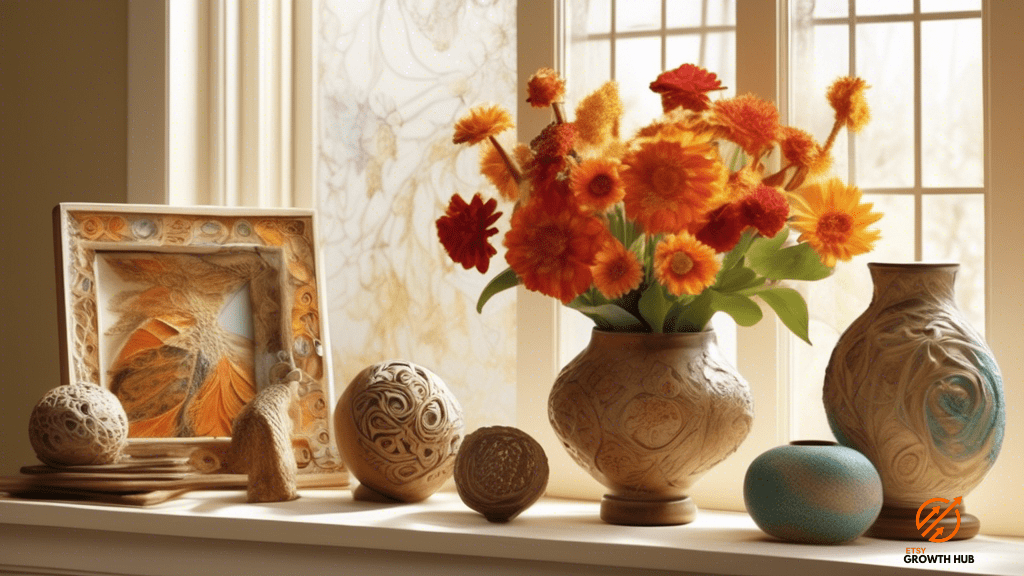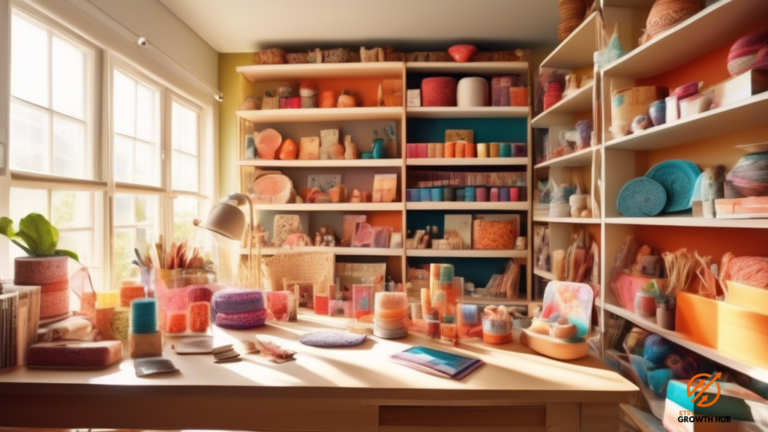Are you an artist who struggles with pricing your handmade artwork? Do you find it challenging to determine the right value for your creations?
Look no further, as this article will provide you with strategies to effectively price your artwork. Pricing your handmade artwork can be a complex task, but by considering factors such as material and labor costs, researching market trends and competitors, and evaluating customer perception and demand, you can establish a pricing strategy that is both profitable and sustainable.
When determining the value of your artwork, it is essential to take into account the material and labor costs involved. Consider the expenses incurred in acquiring high-quality materials and the time invested in creating your masterpiece. By calculating these costs, you can ensure that your pricing reflects the value of your time and resources.
Additionally, researching market trends and competitors can give you insights into the current demand for similar artwork and the prices being charged. This information can help you set competitive prices that attract customers while still allowing you to make a profit.
Remember, finding the right balance between pricing for profitability and sustainability is crucial for the long-term success of your art business.
Key Takeaways
- Consider factors such as material and labor costs, market trends, and customer perception when determining the value of handmade artwork.
- Research and compare prices of similar artworks to establish a competitive pricing strategy.
- Take into account the cost of materials and the time and effort invested in creating the artwork.
- Regularly assess and adapt pricing strategy to stay competitive in the market.
Determining the Value of Your Artwork
Now that you’ve poured your heart and soul into creating your beautiful handmade artwork, it’s time to determine its true value and make sure you’re pricing it just right.
The first step in determining the value of your artwork is to consider the materials and time you invested in creating it. Take into account the cost of the materials used, such as paint, canvas, or clay, as well as any additional tools or supplies. Consider the amount of time it took you to create the artwork, including the planning, sketching, and execution. Remember to also factor in any additional costs, such as framing or packaging, that may be necessary for selling your artwork.
Next, consider the uniqueness and originality of your artwork. Ask yourself if there are any similar pieces on the market and how your artwork stands out from the rest. Take into account your artistic style, technique, and the level of skill and craftsmanship demonstrated in your work. Additionally, consider your reputation and the demand for your artwork. If you have a strong following or have received positive feedback and recognition in the past, this can increase the value of your artwork.
Finally, it’s important to research and compare prices of similar artworks in the market. Look at online platforms, galleries, or local art shows to get an idea of what other artists are charging for their work. This will help you gauge a reasonable price range for your own artwork and ensure that you’re not over or underpricing it.
Remember, pricing your artwork can be a subjective process, but by considering these factors, you can determine the true value of your artwork and set a fair price that reflects your talent and hard work.
Considering Material and Labor Costs
When determining the value of your handmade artwork, it’s important to take into account both the costs of materials and the time and effort put into creating the piece.
Materials can include everything from paint and canvas to brushes and frames. Consider the quality of the materials you used and the cost to replace them. If you’re using high-quality materials, it’s reasonable to charge a higher price for your artwork.
Labor costs are another factor to consider. Think about the amount of time and effort you put into creating the piece. Did it take you several hours or even days to complete? Factor in the hourly wage you would like to earn for your work and multiply that by the number of hours you spent. It’s important to value your time and expertise as an artist.
By considering both material and labor costs, you can come up with a fair price for your handmade artwork.
Remember to also take into account the current market value for similar pieces and the demand for your work. Pricing your artwork too high may deter potential buyers, while pricing it too low may undervalue your skills and time. Finding the right balance is key to setting a price that reflects the value of your art.
Researching Market Trends and Competitors
By researching market trends and studying competitors, you can gain valuable insights and create a competitive advantage for selling your creations. Understanding what’s currently popular in the market and what prices competitors are charging can help you determine the optimal pricing strategy for your handmade artwork. Here are some key benefits of researching market trends and competitors:
- Identifying trends: Researching market trends allows you to stay up-to-date with the latest styles, themes, and designs that are in demand. This knowledge can help you create artwork that aligns with current trends, making it more appealing to potential buyers.
- Pricing benchmark: By studying competitors, you can get a sense of what prices similar artwork is being sold for. This can serve as a benchmark for setting your own prices. It’s important to consider factors such as materials used, level of craftsmanship, and uniqueness when comparing prices.
- Identifying gaps: Analyzing your competitors’ offerings can help you identify gaps in the market that you can fill with your own artwork. For example, if you notice that there’s a lack of artwork in a certain style or theme, you can create pieces that cater to that specific niche, giving you a competitive edge.
- Differentiation: Researching market trends and competitors can help you differentiate your artwork from others. By understanding what sets your creations apart, you can highlight these unique qualities in your marketing and pricing strategy, attracting buyers who’re looking for something different.
By conducting thorough research on market trends and competitors, you can gain valuable insights that can inform your pricing strategy and help you stand out in a crowded marketplace.
Pricing for Profitability and Sustainability
To ensure profitability and sustainability, you need to understand the value of your artwork and how it compares to other artists in the market.
Did you know that according to a recent study, artists who price their work too low actually end up making less profit than those who price it higher? It may seem counterintuitive, but setting a higher price for your handmade artwork can actually increase your overall profit margin.
When you price your work too low, potential customers may perceive it as low quality or lacking value. This can lead to fewer sales and lower demand for your products. On the other hand, if you price your artwork at a higher value, customers may perceive it as being of higher quality and worth the price. This can attract a more niche market of customers who are willing to pay a premium for unique, handmade pieces, resulting in higher profit margins for you.
Additionally, pricing your artwork for profitability and sustainability means taking into account the costs of materials, labor, and overhead expenses. It’s important to calculate the true cost of creating each piece and factor that into your pricing strategy. This includes not only the cost of materials, but also the time and effort you put into creating the artwork.
Many artists often underestimate the value of their own time, but it’s essential to consider it when pricing your work. By accurately pricing your artwork to cover all costs and ensure a reasonable profit margin, you can create a sustainable business model that allows you to continue creating and selling your handmade artwork in the long term.
Evaluating Customer Perception and Demand
Begin by evaluating how customers perceive and demand your unique creations. Understanding how your target market views your artwork and their level of demand can help you determine the appropriate pricing strategy. One way to assess customer perception and demand is by conducting market research and gathering feedback from potential customers. This can be done through surveys, focus groups, or even by engaging with customers directly at art shows or exhibitions. By asking questions about their preferences, perceived value, and willingness to pay, you can gain valuable insights into how your artwork is perceived in the market.
To further analyze customer perception and demand, you can create a table to compare your artwork with similar pieces in the market. This can help you identify any unique features or qualities that set your creations apart. Here is an example of a table you can use:
| Your Artwork | Competitor A | Competitor B | |
|---|---|---|---|
| Price Range | $X-$Y | $X-$Y | $X-$Y |
| Materials Used | High-quality | Average | High-quality |
| Unique Features | Hand-painted | Limited Edition | Customizable |
| Customer Reviews | Positive | Mixed | Positive |
By comparing your artwork to competitors, you can determine how your creations are positioned in terms of pricing, materials used, unique features, and customer reviews. This information can help you understand the perceived value of your artwork and make informed decisions when it comes to pricing. Remember, customer perception and demand can vary, so it’s important to regularly assess and adapt your pricing strategy to stay competitive in the market.
Frequently Asked Questions
How can I effectively market and promote my handmade artwork to increase its perceived value and demand?
To effectively market and promote your handmade artwork, focus on showcasing its unique qualities, such as the materials used or the story behind it. Utilize social media platforms, collaborate with influencers, and participate in local art events to increase its perceived value and demand.
Are there any additional costs or expenses that I should consider when pricing my handmade artwork?
When pricing your handmade artwork, consider additional costs such as materials, packaging, shipping, and any fees or commissions from selling platforms. It’s important to factor in these expenses to ensure you’re covering all your costs and making a profit.
What strategies can I utilize to differentiate my handmade artwork from competitors and stand out in the market?
To differentiate your handmade artwork and stand out in the market, you can unleash your creativity like a tornado, creating unique and innovative designs. Experiment with different materials, techniques, and styles that are unconventional and eye-catching.
Is it necessary to adjust my pricing strategy based on different customer segments or target markets?
Yes, it is necessary to adjust your pricing strategy based on different customer segments or target markets. By tailoring your prices to meet the specific needs and expectations of each segment, you can maximize your sales potential and attract more customers.
How can I gauge the overall success and profitability of my pricing strategy for handmade artwork in the long run?
To gauge the overall success and profitability of your pricing strategy for handmade artwork, track sales and profit margins over time. Think of it like navigating a ship: regular course corrections ensure you stay on the right path to profitability.
Last Updated: January 22, 2024
Disclosure: We may receive affiliate compensation for some of the links in this article at no additional cost to you if you decide to purchase a product. You can read our affiliate disclosure in our privacy policy.
Kevin Fairbanks is your expert navigator in the world of Etsy business. With a passion for creativity and a deep understanding of the e-commerce landscape, Kevin brings a wealth of knowledge to aspiring and established Etsy sellers alike.
As a seasoned entrepreneur and successful owner of multiple Etsy shops, Kevin knows firsthand the challenges and triumphs of the Etsy marketplace. His journey is one of innovation, perseverance, and a keen eye for market trends, making him an invaluable guide for anyone looking to succeed on Etsy.
Kevin’s expertise extends beyond just shop management; he is adept in areas such as SEO optimization, effective marketing strategies, and financial planning for online businesses. His insights are grounded in real-world experience, offering practical and actionable advice.
Join Kevin as he shares his journey and expertise on Etsy Growth Hub. Whether you’re starting your first Etsy shop or looking to expand your existing business, Kevin’s guidance is designed to help you navigate the complexities of Etsy selling with confidence and creativity.
Stay tuned with Kevin’s latest strategies and tips on Etsy Growth Hub to transform your passion into a thriving online business. His dedication to empowering Etsy sellers is evident in every piece of advice he shares, helping you turn your Etsy dreams into reality.
Verified and Approved by:

Kevin Fairbanks
Head of SEO
Like This Article?
Share with your friends
Table of Contents
Latest Articles
Keep Reading
-
Implementing Financial Strategies For Customer Engagement
Boost your financial success by implementing proven strategies for customer engagement. Take your business to the next level today! Learn more about Financial Strategies for Customer Engagement now.
-
How To Price Your Handmade Beauty Products Effectively
Learn the secret to effectively pricing your handmade beauty products and maximizing profits without compromising quality. Don’t miss out on this essential guide – click here now!
-
Riding The Wave: Staying On Top Of Etsy Shop Trends
Stay ahead of the competition on Etsy by mastering the latest shop trends. Learn how to ride the wave of success and maximize your profits. Don’t miss out, click now for insider tips and tricks!




